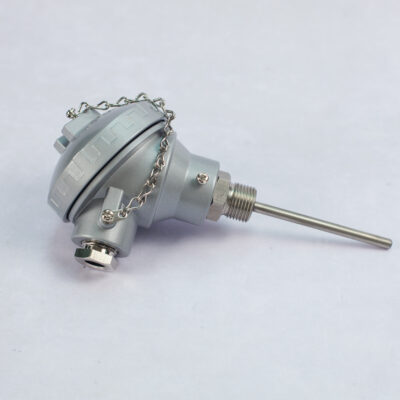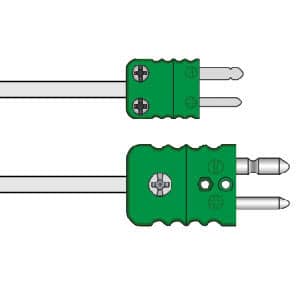What are Type K Thermocouples?
Understanding K Type Thermocouples and Their Importance in Temperature Measurement
The accuracy of temperature measurement is a critical aspect within our customer’s relative industries. Among the many temperature sensing technologies available, type K thermocouples stand out as a popular choice due to their versatility, reliability and wide temperature range.
In this article, we will delve into the intricacies of type K thermocouples and explore their applications, benefits, and the role of temperature transmitters in enhancing their performance.
Process Parameters offers an extensive range of custom-built temperature sensors (Thermocouples, Pt100’s) manufactured to your requirements. Get in touch with our team, or view our range of high-quality thermocouples.
Contact UsThermocouple Sensors for Industrial Applications
Temperature Probes & Sensors
Thermocouple Sensors for Industrial Applications
Thermocouple for Ambient Air Temperature Measurement Sensor – PPL10-T
Temperature Probes & Sensors
What is a Thermocouple?
A thermocouple is an electrical device comprising of two dissimilar electrical conductors that create an electrical junction. It generates a voltage proportional to the temperature, allowing temperature measurement based on this voltage output.
Read our guide on ‘what is a thermocouple?’ for more information.

Thermocouple Types
There are many different thermocouple types depending on the application and operation range required. Each thermocouple type is given a coding letter to denote each of the alloy combinations. The most common code letters for thermocouples are K, J, T and N.
These temperature sensors also have their own thermocouple colour code to aid identification. The primary standard used within the UK and Europe is often referred to simply as the IEC colour code.
What is a K Type Thermocouple?
A k type thermocouple is a temperature sensor composed of two different metal alloys, Chromel (90% nickel and 10% chromium) and Alumel (95% nickel, 2% manganese, 2% aluminium, and 1% silicon).
These thermocouples are widely used for their broad temperature range, from -200°C to 1150°C (-328°F to 2102°F), making them suitable for various industrial applications.

How Do Type K Thermocouples Work?
Type K thermocouples operate based on the thermoelectric effect, which generates a voltage proportional to the temperature difference between their two junctions. This voltage can be measured and correlated to the corresponding temperature using standard calibration tables or electronic devices.
Benefits of Type K Thermocouples
- High Accuracy and Reliability: Type K thermocouples offer excellent accuracy and stability, making them ideal for critical temperature measurements.
- Wide Temperature Range: With an extensive operational range, they are suitable for both extreme high-temperature and cryogenic applications.
- Durability and Longevity: The robust construction of type K thermocouples ensures longevity, even in harsh environments.
- Cost-effectiveness: Compared to other temperature sensors, K type thermocouples provide an affordable solution without compromising performance.
Read our guide on the ‘advantages and disadvantages of thermocouples’ for more information.
Applications of Type K Thermocouples
- Industrial Process Control: Type K thermocouples are widely used in industries like petrochemical, pharmaceutical, and manufacturing, where precise temperature control is vital.
- HVAC Systems: Heating, Ventilation, and Air Conditioning systems benefit from type K thermocouples’ accuracy and reliability for temperature regulation.
- Food and Beverage Industry: Ensuring the right temperature in food processing and storage is critical, making these thermocouples an ideal choice.
- Aerospace and Automotive Applications: K type thermocouples are used in aerospace and automotive industries for engine monitoring, exhaust systems, and more.
- Research and Development: Various scientific research applications rely on the versatility of type K thermocouples for accurate data collection.
Choosing the Right Thermocouple and Equipment
Selecting the appropriate thermocouple type involves considering specific application requirements, calibration, and accuracy needs. Process Parameters offers expert guidance to help businesses make informed choices.

Maintenance and Care of Type K Thermocouples
Regular calibration and testing are essential to ensure the accuracy and reliability of type K thermocouple sensors. Additionally, proper cleaning and protection measures help extend their lifespan.
Process Parameters’ support team can provide valuable maintenance tips as part of your enquiry process.
Contact UsTemperature Transmitters: Enhancing Type K Thermocouple Performance
Temperature transmitters play a crucial role in converting the low voltage output from thermocouples that are type K into a standardised signal (e.g. 4-20mA) suitable for process control systems.
Process Parameters offers a range of temperature transmitters designed to complement Type K thermocouples, ensuring precise and efficient temperature measurements.
Related: What is a Temperature Transmitter?
Why Choose Process Parameters for Type K Thermocouples and Temperature Transmitters?
Type K thermocouples remain a popular choice for temperature measurement due to their wide range, accuracy, and durability.
Process Parameters has established itself as a leading supplier of temperature probes, thermocouples and transmitters. Their product range includes a wide variety of products suitable for diverse industrial applications.
With a focus on quality, accuracy, and customer satisfaction, Process Parameters is the preferred partner for temperature measurement solutions.
Our team of experts will be able to assist you with choosing the right equipment for your specific applications.
For further information please email us at sales@processparameters.co.uk or call 01628 778788.
Send An EnquiryThermocouple Sensors for Industrial Applications
Temperature Probes & Sensors
Thermocouple Sensors for Industrial Applications
Thermocouple for Ambient Air Temperature Measurement Sensor – PPL10-T
Temperature Probes & Sensors
FAQs
What is the difference between k type and j type thermocouple?
What is the colour code for type K thermocouple?
How to connect a k type thermocouple?
- Identify positive (yellow) and negative (red) wires.
- Connect to a compatible meter or controller, maintaining polarity.
- Ensure proper cold junction compensation.
- Use thermocouple-grade extension wire if needed.
- Avoid creating additional junctions.
- Use appropriate connectors (e.g., mini-plug) if required.
- Check connections for continuity and proper insulation.
Related Articles:
- How Does a Thermocouple Work?
- What is a Temperature Transmitter?
- How Accurate are Thermocouples?
- Advantages and Disadvantages of Thermocouples
- Comparing Contact and Non-Contact Temperature Sensors
- What Is A Temperature Sensor?
- Differences Between J and K Type Thermocouples





